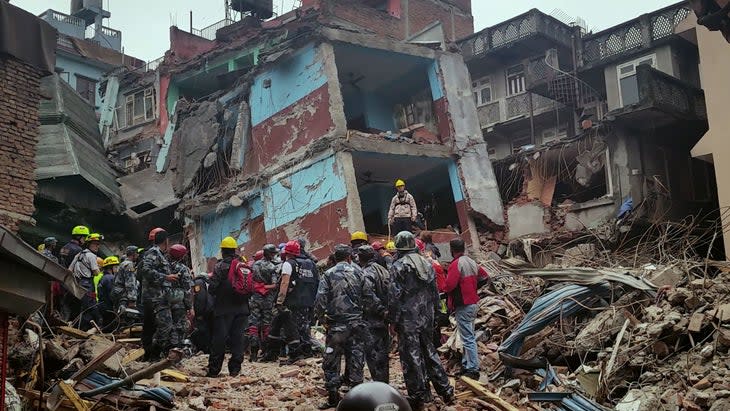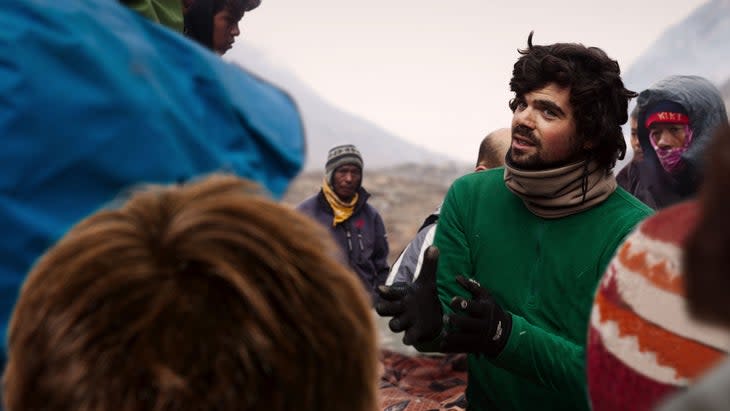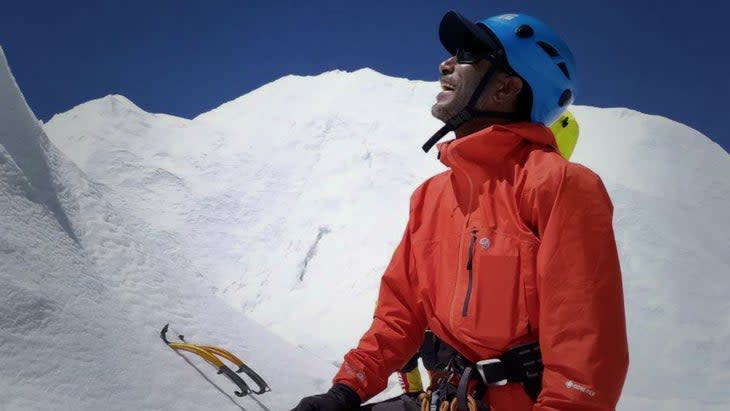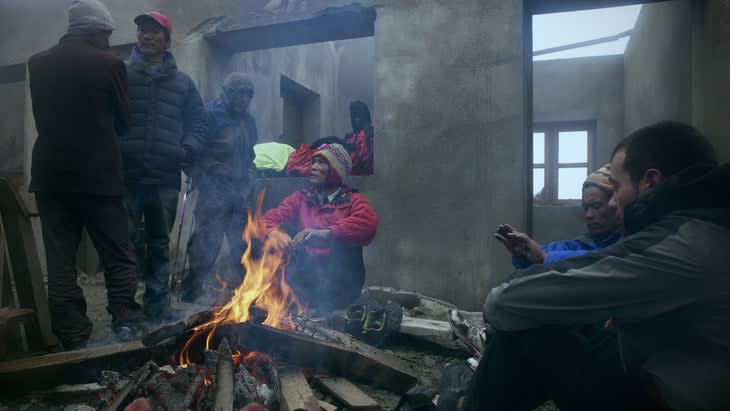Netflix’s ‘Aftershock: Everest and the Nepal Earthquake’ Is About So Much More Than the Mountain
This article originally appeared on Outside
Two weeks ago, I fired up Netflix, and a preview for the new docuseries Aftershock: Everest and the Nepal Earthquake flashed across the screen. The snippet showed a mountaineer standing precariously on a rickety ladder in the Khumbu Icefall, and as a consumer of all things Everest, I immediately clicked through and binged the film's three episodes. As the story unfolded, I saw that there was a balancing act of a different nature at play in the film. While Aftershock is marketed as the latest Everest documentary, the film attempts to tell a story that is much larger than the world's highest peak.
Aftershock documents the horror and devastation caused by the April 2015 earthquake in Nepal that left nearly 9,000 people dead and an estimated 2.5 million homeless. It tackles the question of what happens when millions of people are instantaneously placed in survival situations--do they look out for one another or themselves? Mount Everest, and the avalanche that devastated Base Camp, is of course a chapter in this story. But Aftershock also takes viewers into crumbling buildings in downtown Kathmandu, and high into devastated villages on the other side of the country, to tell a broader story of the disaster.
I recently spoke to British filmmaker Olly Lambert, Aftershock's director, and he said that he and the film's producers constantly weighed how much attention to give the Everest mountaineers, and how much to give to other storylines. "Literally, from day one of the production, the question we asked was how can we ensure that this huge disaster taking place in the Indian subcontinent is not framed as a load of white people bleating about their holiday going wrong," Lambert says. "You could make an entire film about the discussions we had about the title alone."

Complete coverage of a disaster of this size and scope in one film is, of course, impossible. The directors and producers tackle this lofty goal by weaving together three separate survival stories, set in three different locations, that all contain eerily similar elements of terror, sadness, and controversy. The title card tips you off that one of these stories focuses on the climbers and guides who are preparing to ascend Mount Everest when the earthquake hits on the morning of April 25, 2015. Another story is set in the remote Langtang Valley, an off-the-beaten-path destination for trekkers, and it centers on three Israeli hikers and the villagers they meet along the way. The third (and most tear-jerking) story takes place in a hotel in Kathmandu, operated by a reformed (and self-described) Nepalese gangster and his wife and children.
These stories are told through interviews with the people who survived, and with amazing footage captured at each location. There's also some dramatic reenactment to recreate moments that were lost in time.
The team spoke to a Nepalese researcher who showed them how the 22 deaths at Base Camp generated nearly 50 percent of all international headlines about the earthquake itself, and how this disparity in storytelling obfuscated the true size and scope of the disaster. "As filmmakers, we didn't want to fall into the same trap," Lambert says. "We were always wrestling with how to balance Everest with what happened elsewhere."
But Lambert and others also knew that the general public's fascination with Everest would likely suck in viewers who might otherwise skip a film about the Nepalese fight for survival. There was the need to "get bums in seats," as Lambert says, which also loomed large.

Plus, another pragmatic reason made the Everest storyline important: actual footage of the quake. Multiple documentary film crews at Base Camp filmed the avalanche and its aftermath with high-definition cameras. The film's producers had a glut of footage to choose from, and the clips they included show the helplessness that everyone in Base Camp must have felt watching the plume of debris speed toward them. The rain of ice and rocks devastated the camp, killing 22 people, the most fatalities in one event in the history of Everest expeditions.
One poignant series of scenes shows Kiwi mountaineer Dave McKinley in the moments after the avalanche, as he radios climbers higher up in Base Camp to try and assess the damage. "It just so happened that, in the minutes after the quake, a documentary cameraman picked up his incredibly high-quality 4K camera. He had a sound recordist, too, and they just shot the scene," Lambert says. "You actually see it in Dave's eyes when he realizes what is going on. He takes a deep breath, says 'OK, Roger that,' and then he kicks into gear. If I was trying to stage it, I couldn't have shot it better."

Lambert and his crew spent nearly a year trying to decide on the two other storylines to pursue. They worked with Nepalese producers to compile a list of narratives to follow, and then whittled them down based on a variety of factors, including access to filmed footage or photography. Lambert says he wanted to pursue a storyline from the quake's epicenter in the Gorkha District, but no footage of the drama survived. The crew instead was drawn to stories coming from the Langtang Valley and the devastation around Langtang Village. Most mainstream media had overlooked the drama around the Israeli hikers, Lambert says, but rumors circulated within the community about the trio of outsiders and how they had nearly triggered an international incident. (Outside did cover what happened in Langtang Valley in a 2015 feature.)
The Israeli trekkers came upon Langtang Village--a town where they had slept just a few nights before--and discovered that a rockslide had buried the town's buildings and killed most of its inhabitants. I won't spoil what happens, but let's just say that the three trekkers make a blunder that places them in a seemingly life-or-death conflict with the town's survivors. "We tracked down the main characters from what happened on that day, and they were all up for talking about it," Lambert says. "One group of tourists did something that was clearly seen as a transgression, and they paid a price for it. It seemed to echo a lot of the tensions that were playing out on Everest at the same time."
In the Kathmandu story, the efforts to save survivors buried in the rubble become a race against the clock, as well as a socio-political battle between foreign rescue crews and those from Nepal.

In my opinion, this project could have jettisoned any reference to Mount Everest and still been a compelling watch. As a viewer, I tried to put myself in each person's shoes to ask myself how I would have reacted amid such an extreme situation. Would I have been altruistic, or would I have sought some advantage in the survive-or-die scenario? Lambert says that dynamic, ultimately, is what the film is all about--not just an avalanche in the Himalayas.
"Yes, the series we've made is about an earthquake," he says. "But it's really about these people, and how they were changed, and how they were revealed by their actions and behaviors. Something inside of them came out."
For exclusive access to all of our fitness, gear, adventure, and travel stories, plus discounts on trips, events, and gear, sign up for Outside+ today.

